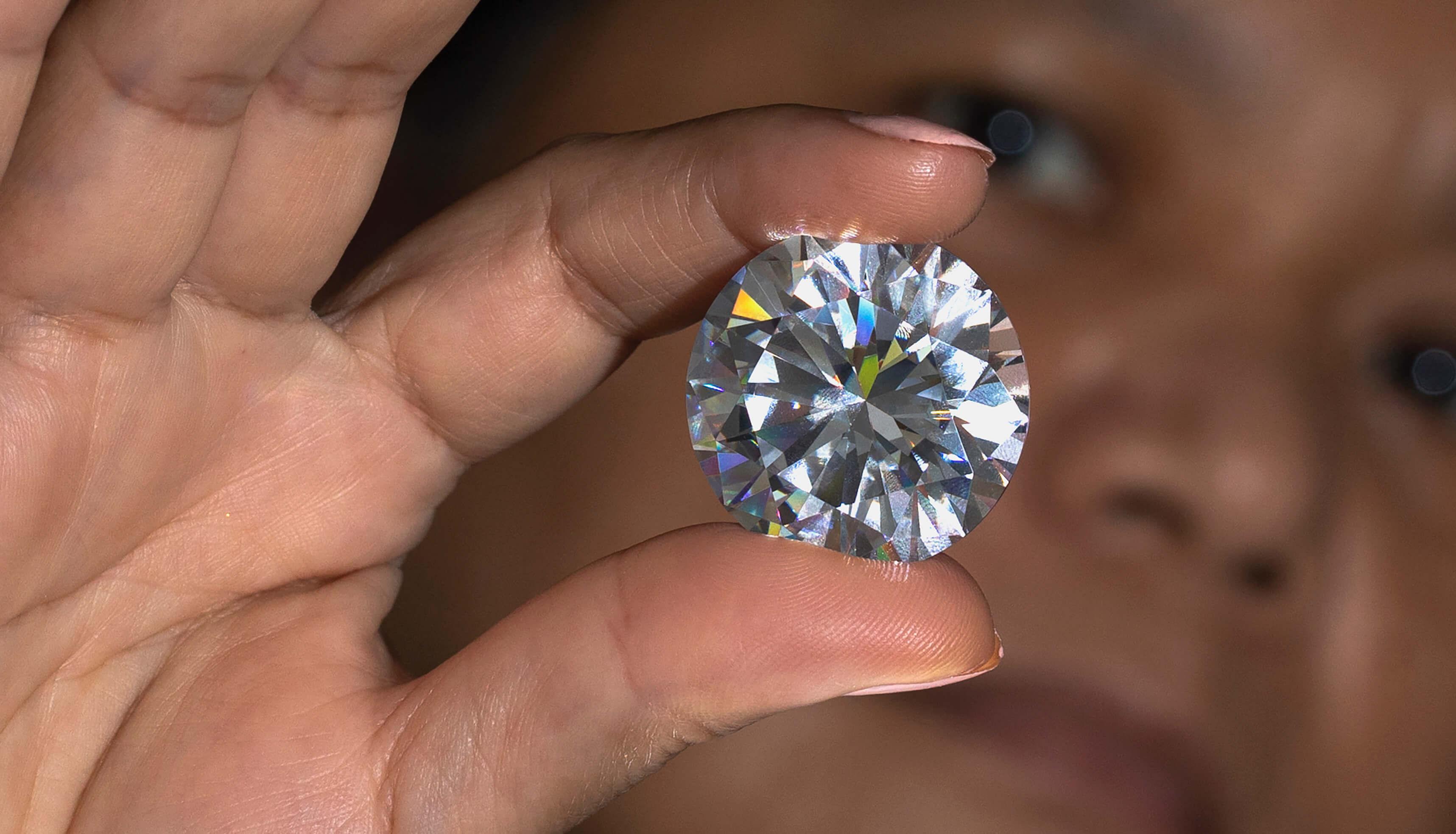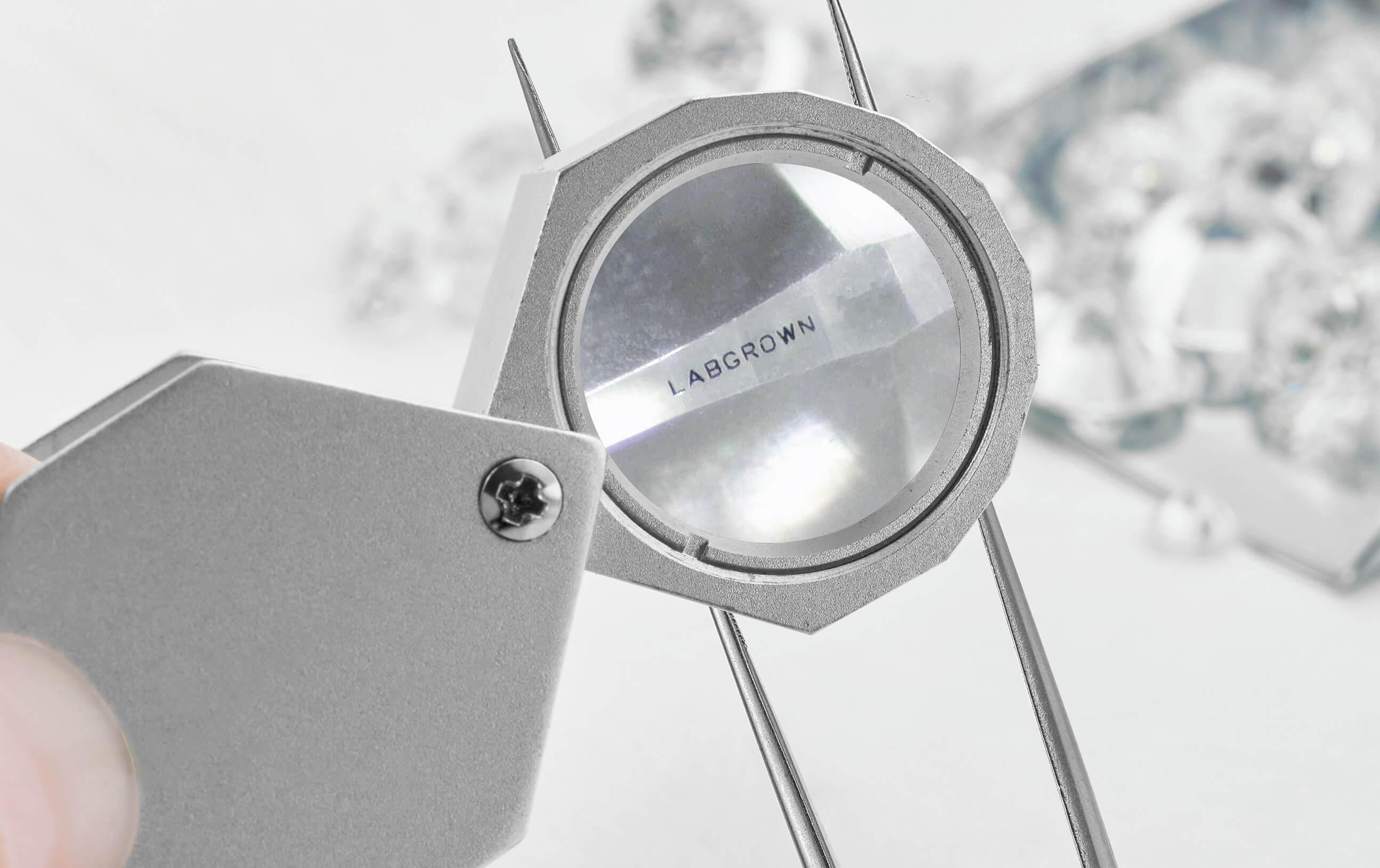
The Truth About “Real” Diamonds
What Are Real Diamonds?
Diamonds are carbon crystals revered and adored for their dazzling intensity of light play, conductivity and hardness.
Because of their refractive ability they can split white light into the color spectrum. They are the hardest substance in the world, at 10 on the Mohs scale. At 3.5–3.53 g/cm3 they are 3.5 times as dense as cold water.
For these reasons they are ubiquitous in jewelry and found in many industrial applications. The hardness and high density of diamond bits help us dig deep into the ground, and diamond engagement rings have become commonplace in many cultures around the world.
What makes a diamond a diamond is its atomic structure. Carbon atoms crystallize in many forms, such as graphite, the filling of your pencils; but diamonds are unique.
In a diamond, carbon atoms form tetrahedral structures that are interlinked in a lattice-work structure. This structure is what gives diamond crystals their hardness and amazing conductive and optical properties: their scintillation, brilliance and fire.
In this article, we'll explain how both mined diamonds, and those grown in a lab, are produced and brought to the market.
Where Do Diamonds Come From?
Diamonds come from two sources. They are either mined from natural deposits in the ground or grown in laboratories.
Natural diamonds, for the most part, form deep in the earth under immense heat and pressure.
Are Lab Grown Diamonds Real Diamonds?
Lab-created diamonds are grown in conditions replicating those in which they naturally develop. The two most common processes for lab-grown production are HPHT, high pressure high temperature; and CVD, chemical vapor deposition.
Mined, Naturally Occurring Diamonds
Pros and Cons of Mined Diamonds
Pros of mined diamonds
- Mined diamonds help us understand the origins of the earth by examining what is in their inclusions (blemishes of various kinds). Since many diamonds formed millions and even billions of years ago, we can learn an enormous amount about the world we live in, and even the universe at large by examining what gets locked in them as they form. They can give us clues to the origin of life on our planet, the changes in climate conditions, volcanic volatility, and even what may have been going on in outer space.
- Currently mined diamonds are the only source of sizes of diamonds exceeding 30 carats.
- Mined diamonds are the only sources for certain fancy-colored diamonds.
- Diamond mining provides a major portion of the economy in several countries, and provides employment for millions of people without significant education or skills.
- Erroneously believed to be rare, diamonds are not rare at all, and are mined in greater quantities than many other precious gems.
Cons of mined diamonds
- Mining is a major source of ethical concerns, due to the use of diamonds to support conflicts and human suffering, grievous labor practices as well as outright forced labor and child labor. Blood diamonds are always natural diamonds.
- Diamond mining can be extremely dangerous and damaging to the environment. Mining operations can drain entire aquifers, disturb and destroy arable land, and use tremendous amounts of energy largely derived from pollution increasing fossil fuels.
- Mined diamonds use tremendous amounts of fossil fuels as they travel thousands of miles from one location around the world to another. This is due to the remote nature of most mines from sorting and cutting centers, which are themselves largely removed from major consumer markets.
- Mined diamonds are increasingly more expensive due to the rising costs of mining in remote localities, shipping multiple times, the number of times they change hands, and an inflated perception of value and scarcity created deliberately by the diamond industry.
- Diamonds are not an easily liquidated investment- it is difficult to resell diamonds that have passed through the market. Moreover, with the exception of stones that have historical value, they do not re-sale for even close to the original purchase price.
How does diamond mining work?
History and Development of Diamond Mining
For two thousand years diamonds were almost exclusively mined in India, with n maximum annual production of 50,000-100,000 carats in the heyday of the famed mined of Golconda. Towards the end of the 17th century CE those mines began drying up. At the same time, diamonds were found in Brazil during the Portuguese conquest. By the 19th century, most diamond mining activity had shifted to Brazil, but these mines produced less than in India.
Then, in 1867 a discovery in South Africa drastically changed the history of diamonds. Where before diamonds were recovered largely from riverbeds that washed them down from their sources, now they were being mined directly from the lamproite and kimberlite pipes of the extinct volcanoes that originally blew them to the surface of earth's crust.
Perhaps more importantly though, they were now being mined in vast quantities, dwarfing the numbers that had ever come out of India or Brazil. South African mining had, in a few years, discovered more diamonds than had ever been found in the history of the world.
Towards the end of the nineteenth century and the beginning of the 20th century large diamond deposits were discovered in other countries in Africa, as well as in Australia, Russia, Canada, and to smaller extents in a number of other countries.
The influx of diamonds almost swamped the market, and some in the diamond industry took measures to artificially control the flow of diamonds to the market. Meanwhile, carats found per year jumped from the tens of thousands to hundreds of thousands, and then to millions of carats in the early 2oth century. In 2005, 120 million carats of diamonds were mined in 2021.
Diamond Mining Today
Historically, diamonds were mined from alluvial (river) deposits. These river beds held diamonds washed downstream over time from their original deposits in lamproite and kimberlite rock. Most artisanal mining continues this ancient, labor intensive practice, accounting for up to 20% of global diamond yield.
Today, most mined diamonds are dug directly out of lamproite and kimberlite pipes. Some mines are massive open pit mine shafts, thousands of feet deep and thousands of feet wide at the top. They are so large that they take hours to traverse by car, winding on steep and treacherous miles-long roads that spiral down the crater.
They can be so large that they produce dangerous wind conditions prohibiting helicopters from flying near the entrance. A few of these colossi can even be seen from space.
These mines displace millions and millions of tons of earth and water every year. They use tremendous amounts of energy- enough to power entire cities. While modern regulations in some countries often force mines to refill the ground when they ultimately close, the earth is scarred with the open pits of former mines from earlier in the 20th and 19th centuries.
Natural diamonds account for the world's blood diamonds and conflict diamonds. While efforts have been made to staunch the flow of these stones, unregulated conflict diamonds remain up to %30 of the market. That is because while efforts like Kimberly regulate some kinds of conflict diamonds, they do not regulate all diamonds sold to support conflict or human rights abuses.
How mined diamonds get to market
Today, the largest amounts of diamonds are mined in countries in Africa (notably Botswana, DR Congo, and South Africa) as well as Russia, Canada, and Australia.
After a diamond is found in a mine, it gets shipped to a holding center, where it is sorted along with other diamonds, to determine whether it is of gem quality, or only suitable for industrial purposes. More than half the diamonds that are mined go to industrial applications. Less than 20% are considered good gem quality.
Once sorted, the gem-quality loose diamonds move on to a cutting and polishing center.
Expert cutters then fashion each diamond into a certain shape, or a number of shapes if the natural stone is large enough. No two rough stones are the same.
The process of fashioning and polishing drastically changes the value as diamond material is lost in the process of turning a rough natural diamond into the gleaming faceted gem you may eventually adore. Since a diamond’s cut (one of the 4 Cs) can drastically alter how well the stone shows its optical properties, it is also the only point at which man has an effect on the positive value of a diamond.
The cut diamonds pass from one hand to another, via wholesalers to retailers until they finally wind up in the hands of a jeweler who sets the stone.
Mined diamonds can travel thousands upon thousands of miles, and change hands as many as a dozen times or more before they finally get to the consumer market. Lab Grown Diamonds
A lab-created diamond is essentially the same as a mined diamond, except for its origin, and often, its price point. Creating diamonds has been a long-time alchemist's dream, and a storybook fantasy, yet, we managed to do it. The technology to create diamonds in a lab began in the 20th century, though the science took centuries to develop. We wrote about the history of lab-made diamond production in an earlier article.
Pros Vs Cons of Lab-Grown Diamonds
Pros of Lab Diamonds
- Diamonds grown in a lab are essentially the same as natural mined diamonds. They have the same optical and chemical properties, electrical and thermal conductivity, and the same color and clarity grades. Even a professional gemologist cannot tell the difference with the naked eye. A modern jeweler's diamond tester cannot tell the difference, only highly specialized equipment and tests can.
- Lab-grown diamonds are almost always less expensive than mined diamonds for the equivalent carat weight. Fancy-colored diamonds made in labs are significantly less expensive than natural stones.
- Man-made diamonds are generally more environmentally sustainable, using less energy, water, and land to produce and bring to market.
- They are more ethical to produce than mined diamonds, are easier to trace, and are almost entirely absent from conflict zones.
- Man-made diamonds use highly skilled and semi-skilled labor, producing more middle-class jobs and giving millions of people economic advancement. Child labor, forced labor, and grievous labor practices are unheard of in lab-grown diamond production.
- They represent a major technological breakthrough. We can manipulate them during the growth process to optimize conductive, optical, and chemical properties and produce stones deliberately created for technological and other applications. A specialized diamond grown in a lab may well be part of your cellphone in the future.
Cons of Lab Diamonds
- Man-made diamonds currently only account for at most 10% of diamonds of the market.
- They suffer from a perceived inequality of value compared to mined diamonds.
- They are not currently available in carat weights as large as their mined counterparts.
- Some colors are not yet available to production in economical quantities.
- Lab-grown diamonds do not resale for their original value.
- They suffer from an erroneous public illusion that they are not, in point of fact, true diamonds.
How are real diamonds made in labs?
Currently, there are two common methods of synthetic diamond production: High Pressure High Temperature, and Chemical Vapor Deposition.
HPHT diamonds
High Pressure High Temperature laboratory production reproduces the conditions diamonds form in at the mantle-crust boundary deep within the earth. There, the high temperatures and pressures force carbon atoms into the tetrahedral carbon crystal of a diamond.
First successfully developed by General Electric in the 1950s, it was not until the late 20th century that the HPHT process was perfected to produce gem-quality diamonds.
How it works is this:
- A seed crystal, from either a previously made lab diamond, or a natural diamond, with another form of carbon, and a metal flux are put inside a specialized chamber. This heated press is capable of reaching enormous pressure and extremely high temperatures.
- With extreme pressure and intense heat, the non-diamond pure carbon material is dissolved by the metal flux, essentially setting the atoms free of their former state.
- After a while, the carbon atoms crystallize, the free ones bonding with those in the diamond seed crystal, which has not dissolved, continuing its tetrahedral structure.
- After several days or weeks, the newly formed, lab-created diamond is taken out, cut and polished into a gleaming gem, evaluated and sold.
CVD Diamonds
Chemical Vapor Deposition was first developed in the 1950s as well, though it would be decades later that it became economically feasible to produce gem-quality diamonds using it.
Diamonds are formed in CVD by introducing a carbon containing gas, such as methane, into a controlled vacuum chamber. In the chamber, microwaves cause the carbon atoms to separate out of the rest of the gas and solidify onto a seed diamond (which can be from a lab-grown diamond or a mined diamond) growing the tetrahedral crystal atomic lattice.
It can take several days or weeks for this process to conclude, after which the newly formed diamonds are sent to cutting and polishing centers, often located nearby.
Which method is better, CVD or HPHT?
Comparing lab diamonds, it's difficult to say which method of production is better. CVD has its advantages of more specialized stones, while HPHT diamonds are, at the moment, more economical to produce in some parts of the world.
Can Diamond testers tell the difference between CVD and HPHT?
Yes, gemological institutes have the specialized laboratory equipment used to determine if a lab-grown diamond is an HPHT diamond or CVD. There is no other way to be sure, other than sending it to a lab for diamond certification.
Can diamond testers tell the difference between a mined diamond and a synthetic diamond?
You cannot tell the difference with the naked eye, or even with basic diamond testers. Since both are the same pure carbon crystal structure, you can’t tell the difference without sending it to a lab to be evaluated. We go into that further in an article about testing the difference between lab-made diamonds and their mined counterparts.
What are NOT real diamonds?
Some of our frequently asked questions are "What are not real diamonds? What are fake diamonds and imitation diamonds?" “How can I tell if a diamond is real or fake?”
There are a number of substances that either may have "diamond" in the name, or appear diamond-like, but are not true diamonds. The most familiar diamond alternatives are cubic zirconia and moissanite, and certain quartz crystals.
The Truth About Real Diamonds
We hope that since you've gotten this far in our article, you’re now assured that a lab-grown diamond is not a fake diamond.
The truth about real diamonds is that they are not all exactly the same in every way, just in one. Some come from the earth, some from labs. What they have in common is that they are all carbon crystals in a tetrahedral atomic structure. As a result, they all have the same hardness and optical properties, though there are natural variations in those properties between one diamond to another, regardless of origin.
If you would like to know more, or are interested in your own stones, we at Michael Gabriels would be happy to help. You can contact us online or on Instagram.



